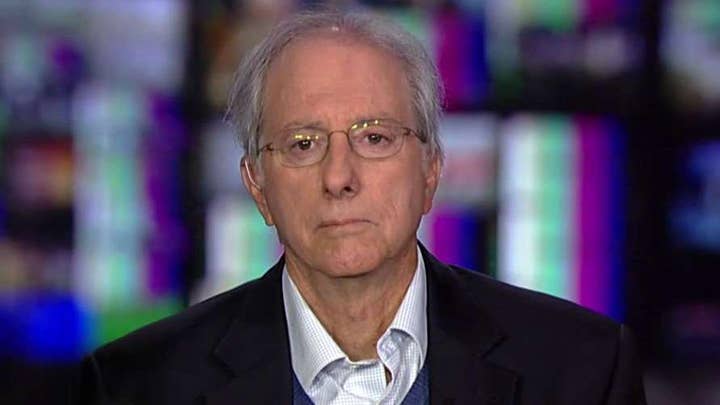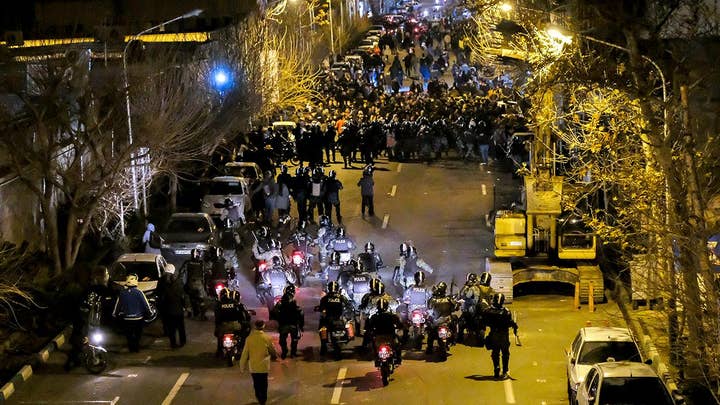Day 2 of protests in Iran over downing of Ukrainian jetliner
Iranian protesters take to the streets for the second straight day, defying authorities; senior foreign affairs correspondent Greg Palkot reports from Kiev, Ukraine.
Iran’s domestic activists have made international headlines on a number of occasions in recent years. Global media reported on the latest protests, which emerged this past weekend in the wake of the regime’s admission that it shot down a passenger airliner amidst heightened tensions with the United States. But what many reports miss is the fact that these protests quickly took on a more anti-government tone, thus underlining the stark divisions between the Iranian people and the country’s ruling theocracy.
In this way, the latest protests fit into a much larger pattern. Public demonstrations in the Islamic Republic seldom remain focused on the specific issues that spark them precisely because Iranians understand that the root of their problems is the regime that governs them.
This was the case in November when Iranians took to the streets in response to Tehran’s announcement that it would be hiking gasoline prices. The move promised to help the mullahs consolidate their hold on power while increasing the economic pain for ordinary Iranians, but the regime grossly underestimated the extent of the public backlash.
IRAN VOWS TO 'PUNISH' THOSE RESPONSIBLE FOR SHOOTING DOWN UKRAINIAN PLANE AS ARRESTS ARE MADE
November’s anti-regime protests shook the regime to its core and changed the domestic political landscape. Not only did the protests quickly engulf the country, but they gave rise to slogans such as “death to the dictator,” thereby leaving little doubt about the public’s appetite for regime change.
Authorities promptly initiated one of the worst crackdowns in years for a nation that has been defined by reflexive political violence since the time of the Iranian Revolution. With the Mujahedin-e- Khalq (MEK) opposition movement’s resistance units spearheading at least 790 individual protests across 190 cities, security forces and the Islamic Revolutionary Guard Corps opened fire with live ammunition, killing an estimated 1,500 people. Regime officials have yet to offer alternative casualty figures or account for the violence visited on protestors.
Were this insufficient to shatter the government’s credibility, Tehran’s response to the Ukrainian Airlines tragedy most certainly did. For several days after the January 8 crash, senior Iranian officials insisted that the crash resulted from technical problems. Rouhani’s mea culpa came only after irrefutable evidence of a missile strike had reached the public and the regime’s denials had been rendered not only false but patently absurd.
The international community should never mistake broad anti-government sentiment for something more narrowly-focused, nor conclude that the discontent on the Iranian street has evaporated simply because unrest has been quelled by suppressive forces.
The downing of Ukraine Airlines Flight 752 underscores the regime’s inherent dishonesty, its refusal to take responsibility for even its most egregious decisions, and its general disregard for ordinary people inside Iran’s territory – both its own people, as well as citizens of the world.
But the sustained nature of the ongoing uprising and the speed with which its latest manifestation has once again turned against the government as a whole demonstrates that the Iranian people are ready for change.
More from Opinion
The international community should never mistake broad anti-government sentiment for something more narrowly-focused, nor conclude that the discontent on the Iranian street has evaporated simply because unrest has been quelled by suppressive forces.
Maryam Rajavi, the President of the National Council of Resistance of Iran, predicted that anti-government sentiment would come back to the fore after a prior nationwide uprising at the end of 2017 and the beginning of 2018.
In fact, she predicted that that protest would spur a “year full of uprisings,” with local demonstrations keeping the message of regime change alive until such time as another triggering incident allowed the people to organize on a national scale yet again.
CLICK HERE TO SIGN UP FOR OUR OPINION NEWSLETTER
The gasoline price hikes incited a massive country-wide uprising in November and the recent missile strike on defenseless citizens has only exacerbated Tehran’s problems. The regime now faces greater pressure from both inside and outside its borders than at any since its inception in 1979.
There are several key takeaways from the resumption of anti-regime protests by thousands of Iranians in Tehran and other cities in 9 provinces since Saturday:
- People are chanting slogans like ‘Commander-in-Chief of the Armed Forces, resign, resign,’ or ‘IRGC commits crime, the supreme leader supports it,’ this time taking great risk and challenging the supreme leader, Ali Khamenei, directly.
- The protesters are openly blaming and challenging the IRGC, the regime’s power base for decades. This reflects a new phase of increased defiance in Iran.
- In recent days, people are chanting ‘No to the oppressor, be it the Shah, or the supreme leader,’ drawing a line with the past and the present and looking to a democratic future.
- Months of protests served to undermine the regime’s propaganda following the killing of Qassem Soleimani. In Tehran and other cities, protesters promptly tore down Soleimani’s posters – a sign of solidarity with the U.S. defensive measure. They also chanted “Soleimani is a murderer, so is his leader (Ali Khamenei).”
CLICK HERE TO GET THE FOX NEWS APP
It is clear that the tide has turned against the mullahs and the Iranian regime is facing crises from all directions.
Senior U.S. officials would be wise to acknowledge that Iran’s theocratic rulers do not represent the Iranian people and formally recognize their desire to topple the religious dictatorship.



